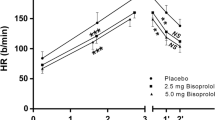Summary
The effect of chronic beta blockade on the haemodynamic response to graded exercise was studied in 18 hypertensive patients treated with bunitrolol, which has partial agonist activity. The patients first received a placebo for 5 to 12 days, then bunitrolol 30 mg daily for one week and subsequently the dose was doubled weekly as necessary upto 240 mg daily. At rest haemodynamic changes after beta blockade were only minor; heart rate decreased by 8% and no significant change was observed in stroke index, cardiac index, (a-v)O2 difference and VO2. The hypotensive effect was not significant and no significant change in mean pulmonary arterial and wedge pressure was observed. Maximal exercise capacity remained unchanged, because of haemodynamic responses. The maximal exercise heart rate was reduced by 25% during beta blockade, which was compensated by a 34% elevation in stroke index, whereas maximal cardiac index and (a-v)O2 difference remained unchanged. There was no consistent change in mean pulmonary artery pressure during maximal exercise, but the mean brachial artery pressure fell by 12%.
Similar content being viewed by others
References
Amery, A., Billiet, L., Boel, A., Fagard, R., Reybrouck, T., Willems, J.: Mechanism of hypotensive effect during beta adrenergic blockade in hypertensive patients. Haemodynamic and renin response to a new cardioselective agent: Tenormin or ICI 66,082. Amer. Heart J.91, 634–642 (1976)
Amery, A., Julius, S., Whitlock, L.S., Conway, J.: Influence of hypertension on the haemodynamic response to exercise. Circulation36, 231–237 (1967)
Barret, A.M.: The pharmacology of beta-adrenoceptor antagonists. In: Recent Advances in Cardiology (ed. J. Hamer), pp. 289–328. Edinburgh, London: Churchill-Livingstone 1973
Baum, T., Rowles, G., Shropshire, A.T., Gluckman, M.: Beta adrenergic blocking and cardiovascular properties of two new substances, KÖ 1313 and KÖ 1366. J. Pharmacol. exp. Ther.176, 339–349 (1971)
Bergmeyer, H.U.: Methods of enzymatic analysis. Chemie3, 1464–1472. New York: Academic Press 1974
De Plaen, J.F., Amery, A., Reybrouck, T.: Comparative potency of atenolol and propranolol as beta adrenergic blocking agents in man. Europ. J. clin. Pharmacol.10, 297–303 (1976)
Gilfrich, H.J., Rahn, K.H., Nicolescu, R.F.: Kreislaufwirkungen eines neuen spezifischen β-Rezeptorenblockers (O-[2-Hydroxy-3-(tert. butylamino)-propoxy]-benzonitril, KÖ 1366). Drug Res.25, 768–771 (1973)
Gloger, K.: Vergleichende Funktionanalytische Untersuchungen der β-adrenolytischer Substanzen KÖ 1366 and Practolol. Drug Res.25, 1300–1303 (1976)
Issekutz, B., Birkhead, N.C., Rodahl, K.: Use of respiratory quotients in assessment of aerobic capacity. J. appl. Physiol.17, 47–50 (1962)
Julius, S., Amery, A., Whitlock, S., Conway, J.: Influence of age on the haemodynamic response to exercise. Circulation36, 222–230 (1967)
Keul, J., Huber, G., Kindermann, W., Burmeister, P., Petersen, K.G.: Die Wirkung eines neuartigen β-Rezeptorenblockers (Bunitrolol) auf Kreislauf unter extremen Stressbedingungen. Med. Welt27, 437–443 (1976)
Klempt, H.W., Bender, F.: Kreislaufwirkungen des neuen β-Rezeptorenblockers KÖ 1366 (Bunitrolol). Drug Res.23, 1064–1070 (1973)
Lund-Johansen, P.: Haemodynamics in early essential hypertension. Acta med. scand. Suppl.482, 1–101 (1967)
McDonough, J.R., Danielson, R.A., Wills, R.E., Vine, D.L.: Maximal cardiac output during exercise in patients with coronary artery disease. Amer. J. Cardiol.33, 25–29 (1974)
Naylor, W.: Comparative partial agonist activity of β-adrenoceptor antagonists. Brit. J. Pharmacol.45, 382–384 (1972)
Pozenel, H.: Ergometrische und hämodynamische Untersuchungen unter Anwendung des Beta-Adrenolytikum Bunitrolol. Med. Welt25, 608–615 (1974)
Reybrouck, T., Amery, A., Billiet, L.: The haemodynamic response to graded exercise following after beta adrenergic blockade. J. appl. Physiol.42, 133–138 (1977)
Ross, J.: Afterload mismatch and preload reserve: a conceptual framework for the analysis of ventricular function. Progr. Cardiovasc. Dis.18, 255–264 (1976)
Sannerstedt, R.: Haemodynamic response to exercise in patients with arterial hypertension. Acta med. scand.180, Suppl. 45 (1966)
Stenberg, J., Wasir, H., Amery, A., Sannerstedt, R., Werkö, L.: Comparative haemodynamic studies in man of adrenergic β-receptor blocking agents without (H93/26 = metoprolol) or with (H87/07) intrinsic sympathomimetic activity. Acta Pharmacol. Toxicol.36, Suppl. 5, 76–84 (1975)
Tarazi, R.C., Dustan, H.P.: Beta adrenergic blockade in hypertension. Practical and theoretical considerations of long-term haemodynamic variables. Amer. J. Cardiol.29, 633–640 (1972)
Wallnöfer, H., Täuber, T.: Klinische Erfahrungen mit dem neuen Beta-Sympathikolytikum KÖ 1366 (Bunitrolol). Wien. med. Wschr.124, 550–557 (1974)
Author information
Authors and Affiliations
Rights and permissions
About this article
Cite this article
Reybrouck, T., Amery, A., Fagard, R. et al. Haemodynamic response to graded exercise during chronic beta-adrenergic blockade with bunitrolol, an agent with intrinsic sympathomimetic activity. Eur J Clin Pharmacol 12, 333–339 (1977). https://doi.org/10.1007/BF00562447
Received:
Revised:
Accepted:
Issue Date:
DOI: https://doi.org/10.1007/BF00562447




